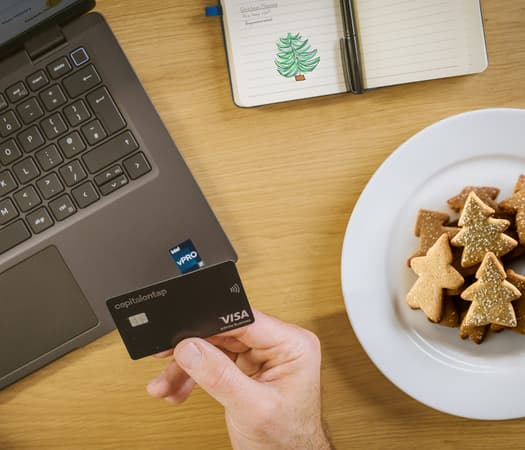Jump to a section
Black Friday and Cyber Monday (BFCM) have become two of the busiest shopping days of the year, and small businesses have just as much to gain as large retailers. In 2024, UK consumers spent £3.63 billion online during BFCM sales, a 5.2% increase on the previous year (Reuters, 2024). Barclaycard also reported a 9.5% rise in overall transactions, showing that shoppers are still keen to spend, even in a challenging economy (Forbes, 2024).
In 2025, Black Friday falls on 28 November, and Cyber Monday on 1 December. Small businesses have a unique opportunity to capture attention during this peak period. Consumers are increasingly looking to shop small and support local brands, making this period not just about discounts, but about building relationships and trust. Let’s walk through six simple steps to help you prepare, sell confidently, and make the most of BFCM in 2025.
1. Start with smart planning
Good planning keeps your business running smoothly when demand peaks. It helps you protect profits, stay in control, and focus your energy where it matters most.
-
Set clear goals. Know what you’re aiming for: more sales, more new customers, or clearing older stock? Defining success early helps you prioritise your time and budget.
-
Review your numbers. Use your sales data to spot which products sell well and which don’t. Focus your promotions on high-margin or popular items.
-
Plan your discounts carefully. Steep discounts attract attention, but too many can erode your profit. Test smaller offers, bundles, or spend-based rewards (like “Spend £50, get £10 off”) to encourage higher baskets.
-
Spread out your sale. Running your offers across a week, rather than a single day, can ease pressure on your systems, team, and delivery partners.
Smart planning also means reviewing your cash flow and making sure you have enough stock and support to keep customers happy from start to finish.
2. Get your website ready
Your website is your shop window, and on Black Friday, you can expect more visitors than usual. Make sure it’s fast, reliable, and easy to use.
-
Every second counts. If your pages take longer than three seconds to load, customers may leave before they even see your offers. Tools like Google PageSpeed Insights can help you spot issues early.
-
Check mobile performance. Nearly 70% of Black Friday and Cyber Monday purchases now happen on phones (Salesfire, 2024). Test your site on different screen sizes and make sure the checkout is just as easy on a phone as it is on desktop.
-
Simplify checkout. Fewer steps mean fewer drop-offs. Offer guest checkout, clear pricing (including delivery), and multiple payment options like Apple Pay or PayPal.
-
Back up your data. Heavy traffic increases the risk of crashes. Regular backups and strong security help protect both your business and your customers.
A smooth online experience builds trust and keeps customers coming back long after the sale ends.
3. Create a clear marketing plan
Even the best offers can go unnoticed without a plan to reach your customers. A little structure goes a long way.
-
Start early. Tease your sale in early November with countdowns or sneak peeks. Early communication builds anticipation and helps you stand out.
-
Use email wisely. Send a short, focused series: one to announce your sale, one mid-promotion, and a final “last chance” reminder. Sending too many emails can cause unsubscribes, which hurts long-term engagement. For inspiration, explore examples on Really Good Emails.
-
Keep messages clear. Use simple subject lines and clear calls-to-action (e.g. Shop Now, Claim Your Offer). Avoid jargon or overly promotional language.
-
Build excitement on social media. Share behind-the-scenes content, countdowns, and limited-stock updates. Engage with comments to stay visible in feeds. For tips on choosing the right platform for your business, see our blog comparing Instagram and TikTok for small businesses.
-
Encourage sharing. Offer small rewards or discounts for referrals or tagged posts. Word-of-mouth remains one of the most trusted forms of marketing.
Remember, marketing isn’t about shouting the loudest. It’s about being clear, helpful, and easy to find when your customers are ready to buy.
4. Optimise for conversions
Once visitors arrive, make it as easy as possible for them to buy.
-
Feature bestsellers. Highlight popular or giftable items prominently on your homepage. Customers are more likely to buy what others already love.
-
Use bundles and upsells. Combine products that naturally go together — for example, a coffee machine and a set of mugs. Bundles help increase order value while offering perceived savings.
-
Show social proof. Reviews, ratings, and testimonials reassure customers they’re making a good choice. If possible, include user-generated photos to add authenticity. For insights into the impact of reviews for small businesses, see our business reviews report.
-
Be transparent about delivery. Clearly display delivery times and costs before checkout. Shoppers appreciate honesty, especially during busy periods.
-
Add subtle urgency. Low-stock messages (“Only 3 left”) or countdown timers can gently encourage customers to act, without pressure.
Small changes, like shortening your checkout form or showing a low-stock notice, can make a big difference to your sales.
5. Prepare for fulfilment and support
A strong BFCM isn’t just about selling more; it’s about keeping your promises.
-
Check your stock early. Contact suppliers well in advance to confirm delivery timelines and avoid last-minute shortages.
-
Plan your dispatch schedule. Communicate clearly about order cut-off dates for pre-Christmas delivery. Transparency prevents disappointment.
-
Prepare your team. Whether you’re packing orders yourself or you have staff, make sure everyone understands their role and key priorities for the weekend.
-
Update your returns policy. Keep it clear and visible. A simple, fair policy encourages hesitant customers to buy with confidence.
-
Boost customer support. Expect more questions during the sale. Adding temporary support hours or live chat can reduce frustration and boost satisfaction.
A smooth post-purchase experience turns first-time shoppers into loyal customers.
6. Measure, learn, and improve
After the rush, take time to review what worked and where there’s room to grow.
-
Review your numbers. Look at total revenue, conversion rates, and your busiest times. Did your offers hit the goals you set?
-
Understand customer behaviour. Use analytics to see which channels and campaigns drove the most traffic. This insight will guide your next promotion.
-
Collect feedback. Ask customers what they enjoyed or what could be improved. Simple post-purchase surveys can uncover valuable insights.
-
Keep learning. Save your notes while everything’s fresh. Next year, you’ll have a ready-made playbook.
Improving even one or two key processes each year makes running your business easier and more efficient.
The bottom line
Black Friday and Cyber Monday are no longer just for the big brands. With the right plan, tools, and preparation, small businesses can thrive during the busiest shopping weekend of the year.
Start early, stay organised, and keep your focus on delivering great value and an even better experience for your customers. That’s how you make running your business easier—not just for one weekend, but all year round.











